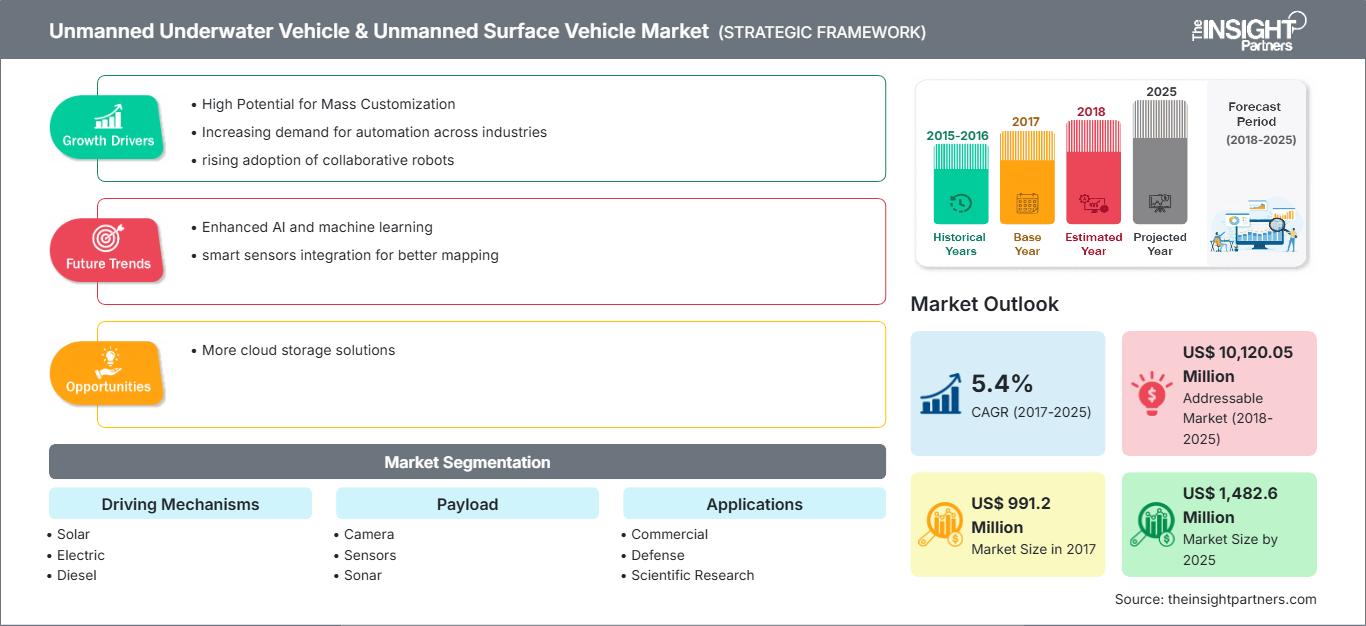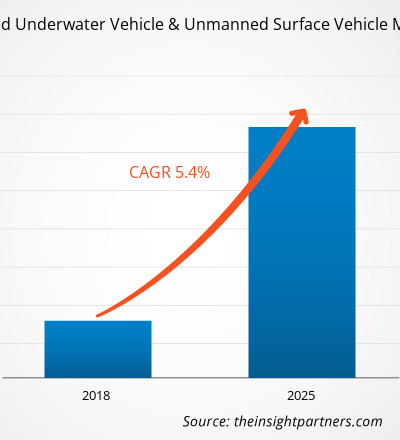全球无人水下航行器和无人水面航行器市场预计将从 2017 年的 9.912 亿美元增长,预计从 2018 年到 2025 年将以 5.4% 的复合年增长率增长,到 2025 年达到 14.826 亿美元。
无人水下航行器和无人水面航行器是在有或没有人工干扰的情况下在水下和水面上操作的无人机。由于对海底监测的需求不断增长,全球 UUV 和 USV 市场的大部分被国防部队占据。目前,石油和天然气勘探组织、水文和海洋调查组织、环境监测组织和搜索和恢复团队等各个商业部门采用 UUV 和 USV 的趋势正在增加。各种科研组织也在采用无人水下航行器和无人水面航行器进行海洋研究和海事调查等。预计未来几年南美无人水下航行器和无人水面航行器市场区域的复合年增长率将达到 4.6%。无人水下航行器和无人水面航行器市场洞察
海洋工业需求大幅增长
随着许多国家努力争取对海上贸易路线和海上资产(如水下石油储备和其他近海资源)的更多控制权,传统的地缘政治争端逐渐加剧。随着这些争端的出现,各国都强调对持续有效的海上监视的需求。其中一个主要的争端是中国与其在南海和太平洋的邻国之间的冲突,这推动了东南亚地区对水下系统的需求,特别是在建设海军实力以应对来自敌人的水面和水下威胁方面。该地区主要国家的海军,尤其是中国和印度,正致力于发展潜艇。然而,为了有效监控这些国家海上边界的非法活动,对无人驾驶航行器的需求也日益增长。由于领土冲突和近期自主研发能力的提升,预计韩国、巴基斯坦和台湾等国家和地区也将在预测期内在该领域投入巨资。这将推动未来几年无人水下航行器和无人水面航行器市场的增长。
持续投资无人海上探索技术
随着沿海地区开发建设的推进,海域变得越来越拥挤,国家和非国家行为者都利用海洋开展各种活动。这促使人们更加重视海上监视和保护。因此,对现代资产的需求日益增长,例如可以通过部署到其他海域来降低人员生命风险并减少与敌方接触的无人驾驶航行器。此外,数字互联应用的蓬勃发展也是无人海洋系统发展的重要因素。互联互通对于现代联网的海上和水下部队至关重要,因为每个传感器和效应器的价值都取决于其在整个C4ISR链中的集成程度。各主要国防工业国家正在大力投资开发将海底传感器、水下平台和水面资产与空中系统、天基资产以及网络作战连接起来的技术。预计这一因素将引发无人资产的进一步扩张,以应对任何潜在的对手威胁。因此,对深海勘探技术开发的持续投资预计将在未来几年为无人水下航行器和无人水面航行器市场参与者提供众多盈利机会。
无人水下航行器和无人水面航行器市场——驱动机制洞察
在全球无人水下航行器和无人水面航行器市场中,无人水面艇市场分为电动和混合动力两种类型,电动 UUV 和 USV 是自主式海上无人机,它们通过改变浮力进行上下运动,类似于剖面浮标。这些浮力变化有助于发电,进而为电池充电,从而推动车辆运行更长时间。这是电动 UUV 和 USV 的主要优势,这一因素增加了最终用户采用该技术的兴趣,帮助市场激增。然而,与其他类型相比,这些车辆的成本制约了市场的增长。由于上述因素,预计在 2018 年至 2025 年的预测期内,电动 UUV 和 USV 在无人水下航行器和无人水面艇市场中的复合年增长率将达到 6.5%。因此,电动无人水下航行器和预计无人水面航行器市场将在预测期内为市场参与者提供大量利润丰厚的商机。
无人水下航行器和无人水面航行器市场 - 应用洞察
根据货架分析,对于全球无人水下航行器和无人水面航行器市场,全球国防力量正越来越多地采用无人水下航行器和无人水面航行器。由于海军和海岸警卫队作战环境大多复杂,因此需要更现代化的技术。需要跟踪在海底作战的友军和敌军,因此正在部署无人水下航行器和无人水面航行器。此外,对用于观察和监视海面活动的水面航行器的需求也在增加。此外,全球国防部队越来越多地在水上和水下部署无人航行器,以防止任何非法活动,因为他们面临着全天候载人监视的巨大挑战。无人系统最大限度地减少了这些挑战,因为这些航行器能够在没有地面站人工干扰的情况下长时间运行。此外,这些无人系统集成了各种传感器、摄像头、声纳和其他先进技术,有助于海军在不涉及人力的情况下收集最大信息量。预计在预测期内,基于国防的无人水下航行器和无人水面航行器市场将以 6.8% 的复合年增长率增长。
无人水下航行器和无人水面航行器市场 -
自定义此报告以满足您的要求
您将免费获得任何报告的定制,包括本报告的部分内容,或国家级分析、Excel 数据包,以及为初创企业和大学提供超值优惠和折扣
无人水下航行器和无人水面航行器市场: 战略洞察

-
获取本报告的主要市场趋势。这个免费样本将包括数据分析,从市场趋势到估计和预测。
全球无人水下航行器和无人水面航行器市场最常采用的策略是收购、市场主动性和新开发。以下列出了一些在无人水下航行器和无人水面航行器市场中运营的参与者近期采取的一些策略:
2018 年:
领先的海洋机器人制造商 Hydroid Inc. 的子公司 Kongsberg Maritime 推出了一款突破性的新型 REMUS M3V 紧凑型机器人。这是一款单人便携式自主水下航行器 (AUV),成本较低。它提供搜索和勘测、情报、监视和侦察 (ISR)、海洋研究等功能。2018 年:Gavia 自主水下航行器制造商 Teledyne Gavia 推出了新的导航模块,将 iXblue 的新款 Phins Compact C3 与 Teledyne RDI 1200 kHz Workhorse 相结合。这使得地球物理勘测、环境勘测和冰下勘测等成为可能。
2017年:康士伯海事旗下子公司Hydroid公司推出了下一代REMUS 100自主水下航行器(AUV)。它提供灵活的导航套件和独有的开放式架构平台,可实现高级自主性。
无人水下航行器和无人水面航行器
无人水下航行器和无人水面航行器市场区域洞察
The Insight Partners 的分析师已详尽阐述了预测期内影响无人水下航行器和无人水面航行器市场的区域趋势和因素。本节还讨论了北美、欧洲、亚太地区、中东和非洲以及南美和中美洲的无人水下航行器和无人水面航行器市场细分和地域分布。
无人水下航行器和无人水面航行器市场报告范围
| 报告属性 | 细节 |
|---|---|
| 市场规模 2017 | US$ 991.2 Million |
| 市场规模 2025 | US$ 1,482.6 Million |
| 全球复合年增长率 (2017 - 2025) | 5.4% |
| 历史数据 | 2015-2016 |
| 预测期 | 2018-2025 |
| 涵盖的领域 |
By 驱动机制
|
| 覆盖地区和国家 |
北美
|
| 市场领导者和主要公司简介 |
|
无人水下航行器和无人水面航行器市场参与者密度:了解其对业务动态的影响
无人水下航行器和无人水面航行器市场正在快速增长,这得益于终端用户需求的不断增长,而这些需求的驱动因素包括消费者偏好的不断变化、技术进步以及对产品优势的认知度不断提高。随着需求的增长,企业正在扩展其产品线,不断创新以满足消费者需求,并抓住新兴趋势,从而进一步推动市场增长。

- 获取 无人水下航行器和无人水面航行器市场 主要参与者概述
全球无人水下航行器和无人水面航行器市场细分
无人水下航行器和无人水面航行器市场 — 按驱动机制
- 太阳能
- 电动
- 柴油
无人水下航行器和无人水面航行器市场 — 按有效载荷
- 摄像头
- 传感器
- 声纳
- 导航系统
- 其他
无人水下航行器和无人水面航行器市场 — 按应用
- 商业
- 国防
- 研究
无人水下航行器和无人水面航行器市场 — 按应用
- 商业
- 国防
- 研究
无人水下航行器和无人水面航行器市场 - 按地区
-
北美
- 美国
- 加拿大
- 墨西哥
-
欧洲
- 法国
- 德国
- 俄罗斯
- 英国
-
亚太地区 (APAC)
- 日本
- 中国
- 印度
- 韩国
-
中东和非洲
- 沙特阿拉伯
- 阿联酋
- 南非
-
南美
- 巴西
无人水下航行器和无人水面车辆市场 - 公司简介
- Kongsberg Gruppen
- Teledyne Technologies
- Lockheed Martin
- ASV Global
- Atlas Elektronik
- ECA Group
- Rafael Advanced Defense Systems
- 概述动力学
- 波音
- Clearpath 机器人
- 历史分析(2 年)、基准年、预测(7 年)及复合年增长率
- PEST和SWOT分析
- 市场规模、价值/数量 - 全球、区域、国家
- 行业和竞争格局
- Excel 数据集
近期报告
客户评价
购买理由
- 明智的决策
- 了解市场动态
- 竞争分析
- 客户洞察
- 市场预测
- 风险规避
- 战略规划
- 投资论证
- 识别新兴市场
- 优化营销策略
- 提升运营效率
- 顺应监管趋势






















 获取免费样品 - 无人水下航行器和无人水面航行器市场
获取免费样品 - 无人水下航行器和无人水面航行器市场